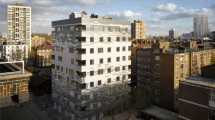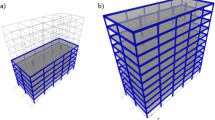Abstract
Fired-clay brick, cement-sand block and cement stabilized earth blocks are the most commonly used material for masonry construction in Sri Lanka. Strength, durability and cost are three major factors that influence the selection of material for wall construction. Even though Sri Lanka has a tropical climate, the benefits of insulating the external walls of the house are often not considered. Apart from thermal comfort of the internal environment, there is concern regarding increase in energy consumption. However, in recent years, as awareness of sustainable and green building concepts increased, interest in using sustainable and thermal comfort materials for house construction has increased. Because external walls play a major role in thermal insulation, there is a need to select suitable wall materials that can be energy efficient and reduce cooling load. Therefore, the present study aims to understand thermal comfort in house units constructed with commonly used wall material such as fired brick, cement-sand block and cement stabilized earth block. Temperature and humidity inside and outside house models were observed to compare the impact of masonry materials on thermal comfort. To compare the thermal comfort performance of the house models, three thermal comfort analysis models: steady-state comfort model, adaptive criteria model and deterministic models were used according to the British Standard European Norm (BS EN) 16798, CIBSE TM52 and ANSI/ASHRAE 55. Results show that house units constructed with cement stabilized earth blocks and fired-clay bricks are significantly more comfortable in terms of temperature and humidity variations. Energy-efficient house units thereby minimized energy consumption through reduction in indoor temperature. Therefore the cement stabilized earth block and fired-clay brick house model are found to be a suitable choice for construction.















Similar content being viewed by others
Availability of data and material
Data can be made available on request by interested parties.
Code availability
Not applicable.
References
Yüksek I (2015) The evaluation of building materials in terms of energy efficiency. Period Polytech Civ Eng 59(1):45–58
Panyakaew S, Fotios S (2008) Agricultural waste materials as thermal insulation for dwellings in Thailand: preliminary results. In: PLEA 2008—25th conference on passive and low energy architecture, Dublin, pp 2017–2020
Iwaro J, Mwasha A (2019) Effects of using coconut fiber–insulated masonry walls to achieve energy efficiency and thermal comfort in residential dwellings. J Archit Eng 25(1):04019001
Ciravoglu A (2008) A research on embodied energy of building materials: reflections on Turkey. In: The 2005 world sustainable building conference, Tokyo
CENSUS (2012) Percentage distribution of occupied housing units by principal material of walls and district. http://www.statistics.gov.lk/PopHouSat/CPH2011/Pages/Activities/Reports/KeyFinding/Key_E.pdf. Accessed 20 Dec 2020
Sathiparan N, De Zoysa HTSM (2018) The effects of using agricultural waste as partial substitute for sand in cement blocks. J Build Eng 19:216–227
Yogananth Y, Thanushan K, Sangeeth P, Coonghe JG, Sathiparan N (2019) Comparison of strength and durability properties between Earth-cement blocks and cement–sand blocks. Innov Infrastruct Solut 4(1):50
Onyekwere N, Chinwe U (2020) Community-driven development strategy for sustainable infrastructure. J Hum Earth Future 1(2):48–59
Vangtook P, Chirarattananon S (2007) Application of radiant cooling as a passive cooling option in hot humid climate. Build Environ 42(2):543–556
CEB (2021) Sri Lanka—country commercial guide. https://www.trade.gov/country-commercial-guides/sri-lanka-energy. Accessed 6 Dec 2021
Arora C (2017) Refrigeration and air conditioning, 3rd edn. Mc Graw Hill Education, New York
Gil L (2015) New Cork-based materials and applications. Materials 8(2):625–637
Sassu M, Giresini L, Bonannini E, Puppio ML (2016) On the use of vibro-compressed units with bio-natural aggregate. Buildings 6(3):40
Arnaud L, Gourlay E (2012) Experimental study of parameters influencing mechanical properties of hemp concretes. Constr Build Mater 28(1):50–56
Elfordy S, Lucas F, Tancret F, Scudeller Y, Goudet L (2008) Mechanical and thermal properties of lime and hemp concrete (“hempcrete”) manufactured by a projection process. Constr Build Mater 22(10):2116–2123
Yan L, Chouw N, Jayaraman K (2014) Flax fibre and its composites—a review. Compos B Eng 56:296–317
Zakaria M, Ahmed M, Hoque MM, Islam S (2016) Scope of using jute fiber for the reinforcement of concrete material. Text Cloth Sustain 2(1):11
Baghban MH, Mahjoub R (2020) Natural kenaf fiber and lc3 binder for sustainable fiber-reinforced cementitious composite: a review. Appl Sci 10(1):357
Mutani G, Azzolino C, Macrì M, Mancuso S (2020) Straw buildings: a good compromise between environmental sustainability and energy-economic savings. Appl Sci 10(8):2858
Thanushan K, Yogananth Y, Sangeeth P, Coonghe JG, Sathiparan N (2019) Strength and durability characteristics of coconut fibre reinforced earth cement blocks. J Nat Fibers, 1–16
Sathiparan N, Rupasinghe MN, Pavithra BHM (2017) Performance of coconut coir reinforced hydraulic cement mortar for surface plastering application. Constr Build Mater 142:23–30
Ahmadi SF, Reisi M (2020) Comparison of mechanical and durability properties of concrete and fired facing bricks. Proc Inst Civ Eng – Struct Build 173(7):512–522
Nayak C, Taware P, Jagadale U, Jadhav N, Morkhade S (2021) Effect of SiO2 and ZnO nano-composites on mechanical and chemical properties of modified concrete. Iran J Sci Technol Trans Civ Eng. https://doi.org/10.1007/s40996-021-00694-9
Kate G, Nayak C, Thakare S (2021) Optimization of sustainable high-strength–high-volume fly ash concrete with and without steel fiber using Taguchi method and multi-regression analysis. Innov Infrastruct Solut 6:102
Parlikar A, Naik C, Nayak C (2021) An experimental study on effect of pharmaceutical industrial waste water on compressive strength of concrete. Int J Innov Res Sci Eng Technol 10(8):11068–11072
Lertsatitthanakorn C, Atthajariyakul S, Soponronnarit S (2009) Techno-economical evaluation of a rice husk ash (RHA) based sand–cement block for reducing solar conduction heat gain to a building. Constr Build Mater 23(1):364–369
Raut S, Mandavgane S, Ralegaonkar R (2014) Thermal performance assessment of recycled paper mill waste-cement bricks using the small-scale model technique. J Energy Eng 140(4):04014001
Madurwar MV, Ralegaonkar RV (2015) Controlling indoor air temperature using bagasse ash bricks. In: Proceedings of the institution of civil engineers—engineering sustainability
Rahman M, Jyoti L, Paul S, Al-Ishmam, Hossain M (2020) Mechanical and thermal performance of cement mortar incorporating super absorbent polymer (SAP). Civ Eng J 6(11):2231–2244
Zafra R, Mayo J, Villareal P, De Padua V, Castillo M, Sundo M, Madlangbayan M (2020) Structural and thermal performance assessment of shipping container as post-disaster housing in tropical climates. Civ Eng J 7(8):1437–1458
Fasogbon S, Wahaabb A, Oyewolaa M (2015) Thermal comfort characteristics of some selected building materials in the regional setting of Ile-Ife, Nigeria. J Nat Resour Dev 5:54–58
Udawattha C, Halwatura R (2018) Thermal performance and structural cooling analysis of brick, cement block, and mud concrete block. Adv Build Energy Res 12(2):150–163
Jeyasegaram S, Sathiparan N (2020) Influence of soil grading on the mechanical behavior of earth cement blocks. MRS Adv 5(54–55):2771–2782
Sajanthan K, Balagasan B, Sathiparan N (2019) Prediction of compressive strength of stabilized earth block masonry. Adv Civ Eng 2019:2072430
Sathiparan N, Anjalee WAV, Kandage KKS (2016) The scale effect on small-scale modelling of cement block masonry. Mater Struct 49(7):2935–2946
Poorveekan K, Ath KMS, Anburuvel A, Sathiparan N (2021) Investigation of the engineering properties of cementless stabilized earth blocks with alkali-activated eggshell and rice husk ash as a binder. Constr Build Mater 277:122371
Seevaratnam V, Uthayakumar D, Sathiparan N (2020) Influence of rice husk ash on characteristics of earth cement blocks. MRS Adv 5(54):2793–2805
Mayooran S, Ragavan S, Sathiparan N (2017) Comparative study on open air burnt low- and high-carbon rice husk ash as partial cement replacement in cement block production. J Build Eng 13:137–145
BS-EN-16798-1 (2019) Energy performance of buildings. Ventilation for buildings. Indoor environmental input parameters for design and assessment of energy performance of buildings addressing indoor air quality, thermal environment, lighting and acoustics. British Standards Institution, London
CIBSE-TM52 (2017) The limits of thermal comfort: avoiding overheating in european buildings. The Chartered Institution of Building Services Engineers, London
ANSI/ASHRAE-Standard-55 (2017) Thermal environmental conditions for human occupancy. Atlanta American Society of Heating, Refrigerating and Air-Conditioning Engineers, Inc, New York
ASTM-C140/C140M (2017) Standard test methods for sampling and testing concrete masonry units and related units. ASTM International, West Conshohocken, PA
ASTM-C109 (2020) Standard test method for compressive strength of hydraulic cement mortars (using 2-in. or [50 mm] cube specimens). ASTM International, West Conshohocken, PA
ASTM-C1006 (2007) Standard test method for splitting tensile strength of masonry units. ASTM International, West Conshohocken, PA
ASTM-C1609/C1609M (2019) Standard test method for flexural performance of fiber-reinforced concrete (using beam with third-point loading). ASTM International, West Conshohocken, PA
Sathiparan N, Rumeshkumar U (2018) Effect of moisture condition on mechanical behavior of low strength brick masonry. J Build Eng 17:23–31
CIBSE (2015) Guide A: environmental design. Chartered Institution of Building Services Engineers, London
IS-SP:41 (1987) Handbook on functional requirements of buildings (other than industrial buildings) (parts 1–4). Bureau of Indian Standard, New Delhi
Jamaludin N, Mohammed NI, Khamidi MF, Wahab SNA (2015) Thermal comfort of residential building in malaysia at different micro-climates. Procedia Soc Behav Sci 170:613–623
Tewari P, Mathur S, Mathur J, Kumar S, Loftness V (2019) Field study on indoor thermal comfort of office buildings using evaporative cooling in the composite climate of India. Energy Build 199:145–163
Manu S, Shukla Y, Rawal R, Thomas LE, de Dear R (2016) Field studies of thermal comfort across multiple climate zones for the subcontinent: India Model for Adaptive Comfort (IMAC). Build Environ 98:55–70
Indraganti M, Ooka R, Rijal HB (2013) Field investigation of comfort temperature in Indian office buildings: a case of Chennai and Hyderabad. Build Environ 65:195–214
Indraganti M, Boussaa D (2018) An adaptive relationship of thermal comfort for the Gulf Cooperation Council (GCC) countries: the case of offices in Qatar. Energy Build 159:201–212
López-Pérez LA, Flores-Prieto JJ, Ríos-Rojas C (2019) Adaptive thermal comfort model for educational buildings in a hot-humid climate. Build Environ 150:181–194
Rijal HB, Humphreys MA, Nicol JF (2017) Towards an adaptive model for thermal comfort in Japanese offices. Build Res Inf 45(7):717–729
Rupp RF, de Dear R, Ghisi E (2018) Field study of mixed-mode office buildings in Southern Brazil using an adaptive thermal comfort framework. Energy Build 158:1475–1486
GB-18883 (2002) Indoor air quality standard. General Administration of Quality Supervision, Inspection and Quarantine of the People’s Republic of China
Banman F, Arens E, Huizenga C, Xu T, Zhang H, Akimoto T, Miura K (1996) The impact of humidity standards on energy efficient cooling in California. Final report to the California Institute for Energy Efficiency, Center for Environmental Design Research, Berkeley
Fountain M, Arens E, Xu T, Banman F, Oguru M (1999) An investigation of thermal comfort at high humidities, indoor environmental quality (IEQ). ASHRAE Trans 105:4282 (RP-860)
Jing S, Li B, Tan M, Liu H (2012) Impact of relative humidity on thermal comfort in a warm environment. Indoor Built Environ 22(4):598–607
Toftum J, Jørgensen AS, Fanger PO (1998) Upper limits for indoor air humidity to avoid uncomfortably humid skin. Energy Build 28(1):1–13
Samuel DGL, Dharmasastha K, Nagendra SMS, Maiya MP (2017) Thermal comfort in traditional buildings composed of local and modern construction materials. Int J Sustain Built Environ 6(2):463–475
Balbis-Morejón M, Rey-Hernández JM, Amaris-Castilla C, Velasco-Gómez E, San José-Alonso JF, Rey-Martínez FJ (2020) Experimental study and analysis of thermal comfort in a university campus building in tropical climate. Sustainability 12(21):8886
Fanger P (1970) The limits of thermal comfort: avoiding overheating in european buildings. McGraw-Hill, New York
Elaiab F (2014) Thermal comfort investigation of multi-storey residential buildings in Mediterranean climate with reference to Darnah. University of Nottingham, Libya
Acknowledgements
The authors express their sincere gratitude for the support given by Concrete Lab, Department of Civil Engineering, Faculty of Engineering, University of Jaffna.
Funding
Not applicable.
Author information
Authors and Affiliations
Corresponding author
Ethics declarations
Conflicts of interest
The authors declare that they have no conflict of interest.
Rights and permissions
About this article
Cite this article
Sathiparan, N., Subramaniam, D.N., Malsara, K.G.N. et al. Thermal comfort analysis of fired-clay brick, cement-sand block and cement stabilized earth block masonry house models. Innov. Infrastruct. Solut. 7, 147 (2022). https://doi.org/10.1007/s41062-022-00744-9
Received:
Accepted:
Published:
DOI: https://doi.org/10.1007/s41062-022-00744-9




